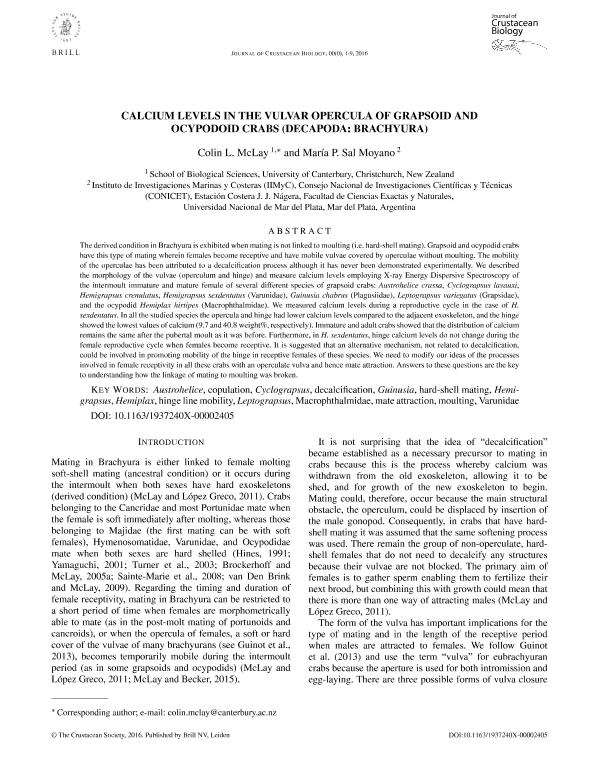Mostrar el registro sencillo del ítem
dc.contributor.author
McLay, Colin L.
dc.contributor.author
Sal Moyano, María Paz

dc.date.available
2018-11-02T18:46:01Z
dc.date.issued
2016-03
dc.identifier.citation
McLay, Colin L.; Sal Moyano, María Paz; Calcium levels in the vulvar opercula of grapsoid and ocypodoid crabs (Decapoda: Brachyura); Crustacean Society; Journal of Crustacean Biology; 36; 2; 3-2016; 220-228
dc.identifier.issn
0278-0372
dc.identifier.uri
http://hdl.handle.net/11336/63526
dc.description.abstract
The derived condition in Brachyura is exhibited when mating is not linked to moulting (i.e. hard-shell mating). Grapsoid and ocypodid crabs have this type of mating wherein females become receptive and have mobile vulvae covered by operculae without moulting. The mobility of the operculae has been attributed to a decalcification process although it has never been demonstrated experimentally. We described the morphology of the vulvae (operculum and hinge) and measure calcium levels employing X-ray Energy Dispersive Spectroscopy of the intermoult immature and mature female of several different species of grapsoid crabs: Austrohelice crassa, Cyclograpsus lavauxi, Hemigrapsus crenulatus, Hemigrapsus sexdentatus (Varunidae), Guinusia chabrus (Plagusiidae), Leptograpsus variegatus (Grapsidae), and the ocypodid Hemiplax hirtipes (Macrophthalmidae). We measured calcium levels during a reproductive cycle in the case of H. sexdentatus. In all the studied species the opercula and hinge had lower calcium levels compared to the adjacent exoskeleton, and the hinge showed the lowest values of calcium (9.7 and 40.8 weight%, respectively). Immature and adult crabs showed that the distribution of calcium remains the same after the pubertal moult as it was before. Furthermore, in H. sexdentatus, hinge calcium levels do not change during the female reproductive cycle when females become receptive. It is suggested that an alternative mechanism, not related to decalcification, could be involved in promoting mobility of the hinge in receptive females of these species. We need to modify our ideas of the processes involved in female receptivity in all these crabs with an operculate vulva and hence mate attraction. Answers to these questions are the key to understanding how the linkage of mating to moulting was broken.
dc.format
application/pdf
dc.language.iso
eng
dc.publisher
Crustacean Society

dc.rights
info:eu-repo/semantics/openAccess
dc.rights.uri
https://creativecommons.org/licenses/by-nc-sa/2.5/ar/
dc.subject
Austrohelice
dc.subject
Copulation
dc.subject
Cyclograpsus
dc.subject
Decalcification
dc.subject
Guinusia
dc.subject
Hard-Shell Mating
dc.subject
Hemigrapsus
dc.subject
Hemiplax
dc.subject
Hinge Linemobility
dc.subject
Leptograpsus
dc.subject
Macrophthalmidae
dc.subject
Mate Attraction
dc.subject
Moulting
dc.subject
Varunidae
dc.subject.classification
Otras Ciencias Biológicas

dc.subject.classification
Ciencias Biológicas

dc.subject.classification
CIENCIAS NATURALES Y EXACTAS

dc.title
Calcium levels in the vulvar opercula of grapsoid and ocypodoid crabs (Decapoda: Brachyura)
dc.type
info:eu-repo/semantics/article
dc.type
info:ar-repo/semantics/artículo
dc.type
info:eu-repo/semantics/publishedVersion
dc.date.updated
2018-10-12T18:06:58Z
dc.identifier.eissn
1937-240X
dc.journal.volume
36
dc.journal.number
2
dc.journal.pagination
220-228
dc.journal.pais
Estados Unidos

dc.description.fil
Fil: McLay, Colin L.. University Of Canterbury; Nueva Zelanda
dc.description.fil
Fil: Sal Moyano, María Paz. Consejo Nacional de Investigaciones Científicas y Técnicas. Centro Científico Tecnológico Conicet - Mar del Plata. Instituto de Investigaciones Marinas y Costeras. Universidad Nacional de Mar del Plata. Facultad de Ciencia Exactas y Naturales. Instituto de Investigaciones Marinas y Costeras; Argentina
dc.journal.title
Journal of Crustacean Biology

dc.relation.alternativeid
info:eu-repo/semantics/altIdentifier/doi/http://dx.doi.org/10.1163/1937240X-00002405
dc.relation.alternativeid
info:eu-repo/semantics/altIdentifier/url/https://academic.oup.com/jcb/article/36/2/220/2547967
Archivos asociados
